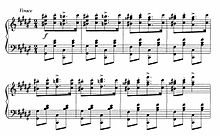Look up friss in Wiktionary, the free dictionary.
Friska, also known as Friss, (from Hungarian: friss, fresh, pronounced frish) is a term used in Hungarian folk dance. It's used in Hungarian dances where there is a sudden shift to a faster tempo in a certain section of the dance. This faster tempo section is called the friss or friska. Examples of Hungarian folk dances which have a friska section include the csárdás and the verbunkos.[1]

Portions of Liszt's Hungarian Rhapsodies (all except rhapsodies 3, 5 and 17) take their form from the csárdás and contain a friska section.[2] The friska is generally either turbulent or jubilant in tone. The Friska of Hungarian Rhapsody No. 2 is also the most well-known of the Hungarian Rhapsodies.
See also
editReferences
edit- ^ "Friss". Grove Music Online. Oxford University Press. 2001. doi:10.1093/gmo/9781561592630.article.10287.
- ^ Martin, György (1974). Hungarian Folk Dances. Corvina Press. ISBN 978-0-8002-1518-7.